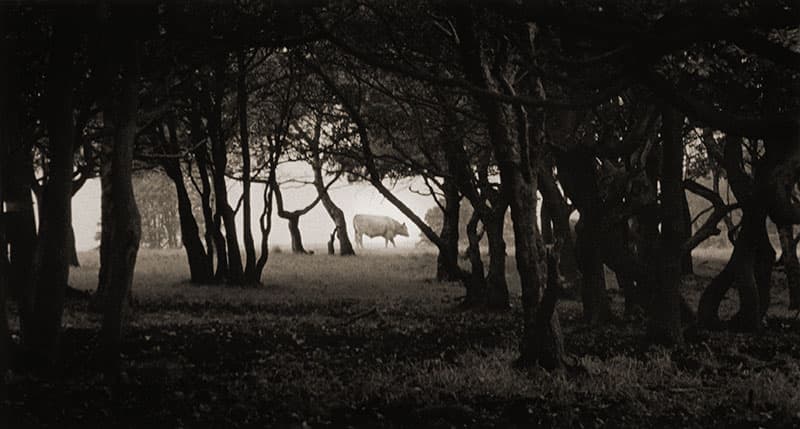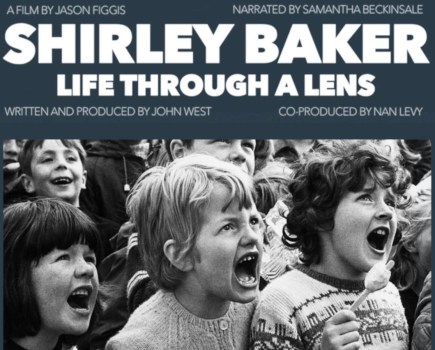Photo Insight with Andrew Sanderson

A renowned photographer, tutor, author and Ilford Master Printer, Andrew Sanderson offers practical tips on working with film and traditional darkroom techniques
I’ll start off by saying that, technically, this is not one of my best shots. It has a touch of underexposure and suffers from a bit of camera shake, too. Yet even so, it is still one of my own favourite photographs.
The photograph is one of a cow in a clearing, shot through the woods. The trees form a natural frame around the beast, which sits proudly in the centre, a little way off and slightly shrouded by the fading light.
The woods where this shot was taken were around Honley, a village near Huddersfield in West Yorkshire. There are quite a few woods in this area, but these ones, Dean Woods, were accessed off Meltham Road in the town.
Honley is a large village that benefits from being situated on the banks of the River Holme, making for some interesting photographic opportunities. Honley Woods is one of West Yorkshire’s largest remaining ancient semi-natural woodland areas. Covering 60 hectares, it is an important example of upland oak woodland. The woods retain many features, such as quarries, coal pits and boundaries, that were shown on ordinance survey maps hundreds of years ago. Further back, there are also examples of earthworks and burials dating back from the Bronze to the Iron Age.
The woods are home to a large variety of birds and insects, including redstarts, woodwarblers, treecreepers and speckled wood butterflies. And among all this history and natural beauty, I discovered this cow that was to become the centre of my photo composition.
I remember the day that I captured this shot. I had gone out walking locally one evening and taken my 35mm Pentax LX camera with a standard 50mm lens, a wide 24mm lens and a medium telephoto 135mm. I shot a few frames over the next couple of hours, and as the light began to drop I made my way home.
As I passed through these woods, I noticed a cow at the outer edge of the trees. The cow was partially hidden behind the woodland and it was eating bits of grass, then moving slowly forward. The cow continued in this fashion for some time as I watched it.

I saw a gap in the woods where I could get a clear shot of the cow and where I knew it would suit the composition I had in mind. However, the cow was taking its time getting to my chosen point. I decided that although it might take some time to get there, it would be worth waiting for. As I waited, though, the light was becoming dimmer. I knew that I needed a shutter speed of at least 1/125sec, and possibly faster with the medium telephoto that I needed to get the shot, so time seemed to be against me.
By the time the awkward beast eventually sauntered into the ideal position, the light was less than ideal. I took a couple of shots, I think at about 1/60 sec, steadying the camera as well as I could without a tripod to hand, and hoped for the best.
When I got it into the darkroom, I cropped it slightly to the more letterbox shape you see here and I burned in the outer edges a little, too. This was followed by sepia toning. Sepia toning is a fairly simple darkroom process, although you need to be prepared. After fully washing your print, place it in a tray of sepia bleach (not household bleach) for 1-2mins until the light and midtones fade. Rinse the image for about 3mins to remove the bleach and then place the print into your sepia toning mix, at which point you will start to notice the image reappearing. Remove it from the toner tray once it has reached your desired look. Wash for the print for 20-30mins and dry, and you have your beautifully sepia-toned photo.
As I stated at the beginning of the article, this is technically not one of my best photographs, but I love the composition and would rather have this slightly soft version than not to have got the shot at all. I believe this is something well worth remembering when you go out and shoot. Although it might not be your best work, would you rather try to get the shot anyway or leave regretting that you didn’t? Even if the light isn’t perfect or you don’t have a tripod with you, attempting to capture a moment might just produce something you love – technically perfect or not!
I did the right thing waiting for that perfect moment, as this has been one of my most popular shots and I have sold a number of prints of it over the years.
Andrew Sanderson was talking to Debbi Allen

If you would like to read more about paper negatives, Andrew’s book Paper Negative Photography is available from www.blurb.com, price £15







